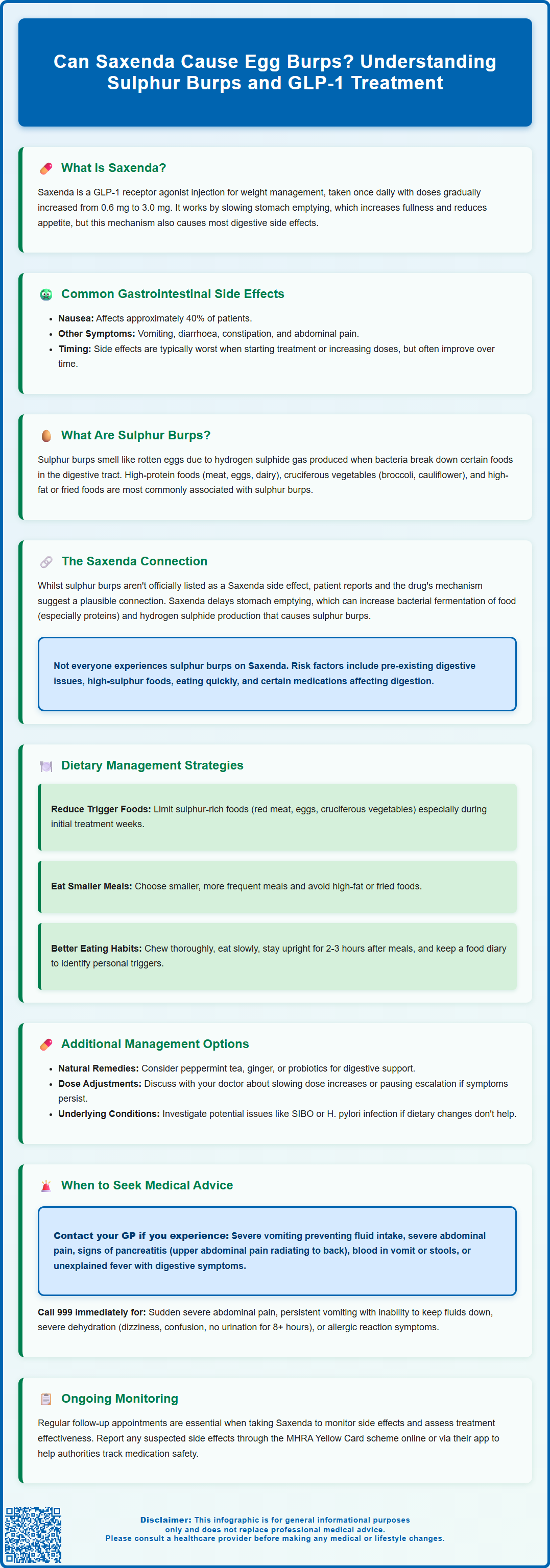Mounjaro®
Dual-agonist support that helps curb appetite, hunger, and cravings to drive substantial, sustained weight loss.
- ~22.5% average body weight loss
- Significant weight reduction
- Improves blood sugar levels
- Clinically proven weight loss

Saxenda (liraglutide) is a GLP-1 receptor agonist licensed in the UK for weight management in adults and adolescents meeting specific criteria. Whilst gastrointestinal side effects such as nausea and vomiting are well documented, some patients report experiencing sulphur burps—also known as egg burps—characterised by a distinctive rotten egg odour. Although not explicitly listed in official product information, this symptom may be linked to Saxenda's mechanism of slowing gastric emptying, which can promote bacterial fermentation and hydrogen sulphide production. Understanding this potential side effect, its underlying causes, and practical management strategies can help patients navigate treatment more comfortably and make informed decisions about their weight management journey.
Summary: Saxenda may contribute to sulphur burps (egg burps) through its mechanism of slowing gastric emptying, which can promote bacterial fermentation and hydrogen sulphide production, though this is not explicitly listed as an official side effect.
Saxenda (liraglutide 6 mg/mL) is a prescription medicine licensed in the UK for weight management in adults with obesity or those who are overweight with weight-related health conditions. It is also licensed for adolescents aged 12 years and above who meet specific criteria. It belongs to a class of medications called glucagon-like peptide-1 (GLP-1) receptor agonists, which work by mimicking a naturally occurring hormone that regulates appetite and food intake.
Saxenda is administered as a once-daily subcutaneous injection, with the dose titrated weekly from 0.6 mg to a maintenance dose of up to 3.0 mg. It can be taken at any time of day, independent of meals.
The mechanism of action of Saxenda involves slowing gastric emptying, which means food remains in the stomach for longer periods. This delayed emptying contributes to increased feelings of fullness and reduced appetite, supporting weight loss efforts. However, this same mechanism is directly responsible for many of the gastrointestinal side effects associated with the medication.
Gastrointestinal adverse effects are very common with Saxenda, affecting the majority of patients to some degree. According to the MHRA-approved Summary of Product Characteristics, the most frequently reported side effects include nausea (affecting approximately 40% of patients), vomiting, diarrhoea, constipation, dyspepsia (indigestion), and abdominal pain. These effects are typically most pronounced when starting treatment or increasing the dose, and often diminish over time as the body adjusts to the medication.
Whilst nausea is the most commonly reported gastrointestinal complaint, other digestive symptoms can occur. Understanding the full spectrum of potential side effects, including less commonly discussed symptoms such as sulphur burps (also known as egg burps), helps patients make informed decisions and manage their treatment effectively. The gastrointestinal tolerability of Saxenda is an important consideration in treatment adherence and overall patient experience.
Sulphur burps, colloquially known as egg burps, are burps that produce a distinctive smell of rotten eggs or sulphur. This unpleasant odour is caused by hydrogen sulphide gas, which is produced during the digestive process. Whilst occasional sulphur burps can occur in anyone, frequent or persistent episodes often indicate an underlying digestive issue.
Hydrogen sulphide is generated when certain foods are broken down by bacteria in the gastrointestinal tract. Foods that may be associated with sulphur burp production include:
High-protein foods such as red meat, poultry, eggs, and dairy products
Cruciferous vegetables including broccoli, cauliflower, Brussels sprouts, and cabbage
Foods containing sulphites or preservatives
High-fat or fried foods that slow digestion
Several factors may contribute to sulphur burps, including delayed gastric emptying and altered gut motility. When food remains in the stomach and upper digestive tract for extended periods, bacterial fermentation increases, potentially producing greater quantities of hydrogen sulphide gas. This gas can then be expelled through burping, carrying the characteristic foul odour.
Several conditions can predispose individuals to sulphur burps, including gastroesophageal reflux disease (GORD), small intestinal bacterial overgrowth (SIBO), gastroparesis (delayed stomach emptying), certain gastrointestinal infections, and food intolerances. Infectious causes such as giardiasis should be considered if sulphur burps are accompanied by diarrhoea, fever, or recent travel history. Additionally, any factor that significantly slows digestive transit time may contribute to this symptom. Understanding these underlying mechanisms is relevant when considering why certain medications, particularly those that deliberately slow gastric emptying, might increase the likelihood of experiencing sulphur burps.

Sulphur burps are not specifically listed in the official product information for Saxenda, but belching/eructation and other gastrointestinal symptoms are recognised adverse effects according to the MHRA-approved Summary of Product Characteristics. Patient reports and clinical experience suggest that some individuals taking Saxenda do experience sulphur burps, and there are plausible pharmacological reasons why this connection might exist.
The most likely explanation relates to Saxenda's mechanism of slowing gastric emptying. By design, liraglutide delays the rate at which food leaves the stomach and moves through the digestive system. This prolonged transit time may create conditions that favour bacterial fermentation of food particles, particularly protein-rich foods, potentially leading to increased hydrogen sulphide production. Essentially, the same therapeutic action that promotes satiety and weight loss may inadvertently create an environment that could contribute to sulphur burp formation.
Additionally, Saxenda can cause changes in digestive patterns and gut motility. Some patients report changes in bowel habits, bloating, and increased flatulence alongside treatment. These symptoms suggest alterations in digestive function that could potentially contribute to sulphur burp occurrence, though it's worth noting that the gastric emptying delay may attenuate over time while still contributing to early gastrointestinal symptoms.
Individual susceptibility varies considerably. Not all Saxenda users will experience sulphur burps, and those who do may find the symptom occurs primarily during dose escalation or after consuming particular foods. Factors that may increase risk include pre-existing digestive conditions, dietary choices high in sulphur-containing foods, rapid eating habits, and concurrent medications affecting gut motility.
It is important to note that whilst sulphur burps can be unpleasant and socially embarrassing, they are generally not medically serious in isolation. However, if accompanied by severe abdominal pain, persistent vomiting, bloody stools, or significant weight loss beyond expected therapeutic effects, medical evaluation is warranted to rule out other gastrointestinal conditions.
If you experience sulphur burps whilst taking Saxenda, several practical dietary and lifestyle modifications can help reduce their frequency and severity. These strategies focus on minimising hydrogen sulphide production and supporting optimal digestion.
Dietary adjustments represent the first-line approach:
Reduce intake of sulphur-rich foods, particularly during the initial weeks of treatment or after dose increases. This includes limiting red meat, eggs, cruciferous vegetables, and high-protein processed foods
Eat smaller, more frequent meals rather than large portions, which can overwhelm the already-slowed digestive system
Avoid high-fat and fried foods that further delay gastric emptying
Stay well-hydrated throughout the day to support digestive function
Limit carbonated beverages which can increase burping and bloating
Identify personal trigger foods by keeping a food diary to track which items precede sulphur burps
Eating habits and timing also play important roles:
Eat slowly and chew thoroughly to reduce the amount of air swallowed and improve initial digestion
Avoid lying down immediately after meals; remain upright for at least two to three hours
Remember that Saxenda can be administered at any time of day, independent of meals, according to the product information.
Over-the-counter remedies that some patients find helpful include:
Peppermint tea or ginger, which some people find supports digestive comfort, though evidence is limited
Probiotics, though evidence for their effectiveness specifically for sulphur burps is limited
Antacids or alginates for associated reflux symptoms, if appropriate
Always check with your pharmacist or healthcare provider before starting any over-the-counter remedies, especially if you take other medications or have other health conditions.
If dietary modifications prove insufficient, discuss the issue with your GP or prescribing clinician. They may suggest temporarily slowing the titration schedule, pausing dose escalation, or reverting to a previously tolerated dose to allow your digestive system more time to adapt. In some cases, additional investigation may be warranted to rule out conditions such as SIBO or Helicobacter pylori infection, which can cause similar symptoms.
Whilst sulphur burps alone are generally not a cause for serious concern, certain accompanying symptoms warrant prompt medical evaluation. Understanding when to contact your GP or healthcare provider ensures appropriate management and helps identify any complications requiring intervention.
Contact your GP or prescribing clinician if you experience:
Severe or persistent nausea and vomiting that prevents adequate fluid or food intake, as this may lead to dehydration
Severe abdominal pain, particularly if sharp, constant, or localised to a specific area
Signs of pancreatitis, including persistent severe pain in the upper abdomen that may radiate to the back, often accompanied by nausea and vomiting
Blood in vomit or stools, which may appear red or have a dark, tar-like appearance
Symptoms of gallbladder disease, such as pain in the upper right abdomen, particularly after eating fatty meals
Unexplained fever alongside digestive symptoms
Rapid ongoing weight loss with inability to maintain adequate hydration or nutrition
Stop taking Saxenda and seek urgent medical attention (call 999 or attend A&E) if you develop:
Severe, sudden-onset abdominal pain, especially if pancreatitis is suspected
Persistent vomiting with inability to keep down any fluids
Signs of severe dehydration (dizziness, confusion, very dark urine, no urination for 8+ hours) or concerns about acute kidney injury
Allergic reaction symptoms (difficulty breathing, facial swelling, severe rash)
For persistent but non-urgent sulphur burps, schedule a routine appointment with your GP if the symptom continues despite dietary modifications, significantly impacts your quality of life, or you have concerns about continuing Saxenda. Your doctor can assess whether additional investigations are needed, such as breath tests for SIBO or H. pylori, or whether adjusting your weight management strategy would be appropriate.
Remember that NICE guidance on obesity management emphasises the importance of ongoing clinical review for patients taking pharmacological interventions. Regular follow-up appointments provide opportunities to discuss side effects, assess treatment efficacy, and make necessary adjustments to optimise both therapeutic benefit and tolerability.
If you suspect you're experiencing side effects from Saxenda, you can report these through the MHRA Yellow Card scheme at yellowcard.mhra.gov.uk or via the Yellow Card app. This helps authorities monitor medication safety.
Saxenda slows gastric emptying, which can prolong food transit time in the digestive system. This may promote bacterial fermentation of protein-rich foods, leading to increased hydrogen sulphide production and resulting in sulphur burps.
Reduce intake of sulphur-rich foods such as red meat, eggs, and cruciferous vegetables, eat smaller frequent meals, avoid high-fat foods, stay well-hydrated, and eat slowly. If symptoms persist despite dietary changes, consult your GP.
Contact your GP if sulphur burps are accompanied by severe abdominal pain, persistent vomiting, blood in stools, signs of pancreatitis, or if symptoms significantly impact your quality of life despite dietary modifications.
The health-related content published on this site is based on credible scientific sources and is periodically reviewed to ensure accuracy and relevance. Although we aim to reflect the most current medical knowledge, the material is meant for general education and awareness only.
The information on this site is not a substitute for professional medical advice. For any health concerns, please speak with a qualified medical professional. By using this information, you acknowledge responsibility for any decisions made and understand we are not liable for any consequences that may result.
Lorem ipsum dolor sit amet, consectetur adipiscing elit, sed do eiusmod tempor incididunt ut labore et dolore magna aliqua. Ut enim ad minim veniam, quis nostrud exercitation ullamco laboris nisi ut aliquip ex ea commodo consequat. Duis aute irure dolor in reprehenderit in voluptate velit esse cillum dolore eu fugiat nulla pariatur.
Block quote
Ordered list
Unordered list
Bold text
Emphasis
Superscript
Subscript